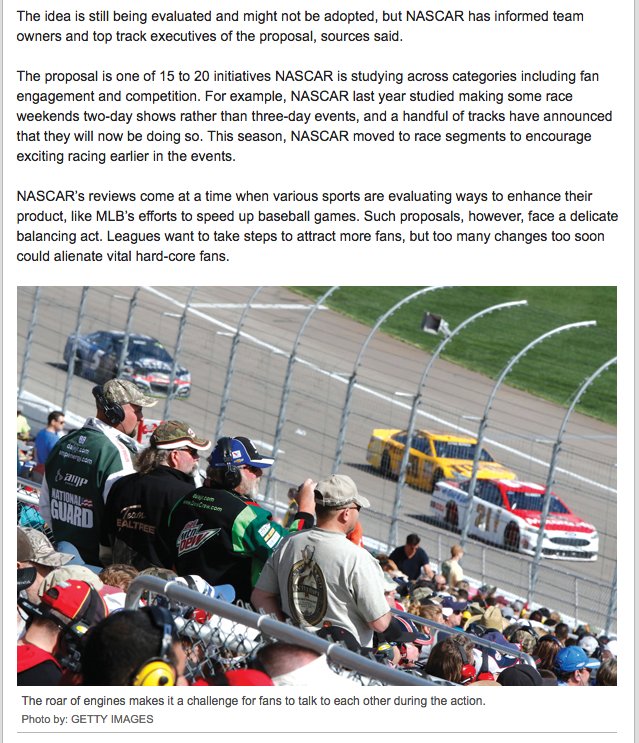NASCAR is considering making its cars quieter, according to several sources, a move that could make it easier for fans to talk to each other during races and engage more socially.
The idea is still being evaluated and might not be adopted, but NASCAR has informed team owners and top track executives of the proposal, sources said.
The proposal is one of 15 to 20 initiatives NASCAR is studying across categories including fan engagement and competition. For example, NASCAR last year studied making some race weekends two-day shows rather than three-day events, and a handful of tracks have announced that they will now be doing so. This season, NASCAR moved to race segments to encourage exciting racing earlier in the events.
NASCAR’s reviews come at a time when various sports are evaluating ways to enhance their product, like MLB’s efforts to speed up baseball games. Such proposals, however, face a delicate balancing act. Leagues want to take steps to attract more fans, but too many changes too soon could alienate vital hard-core fans.
NASCAR events are meccas of sound with ear-splitting engines that make for a uniquely loud experience that many fans have come to love. During Fox broadcasts, the network offers “Crank it up” segments to encourage viewers at home to turn up the volume to better mimic the at-track experience.
However, while numerous fans are smitten by the sound, the decibel level of races can make it difficult to talk with people sitting close by and potentially could hurt young fans’ eardrums.
Quieter cars could be targeted more toward millennials, who place heavy importance on the social experience of attending sporting events. For example, many teams in stick-and-ball sports have developed standing areas where fans can gather and socialize instead of being restricted to a standard seat.
Which NASCAR series the move would be implemented in to start was unclear, but a source said the sanctioning body is considering it for multiple series.
The move could be implemented as soon as next season, sources said. NASCAR declined to comment.
The move would represent only a slight reduction in the sound, according to a source with direct knowledge of the sanctioning body’s review. It could be rolled out over the course of multiple years in a bid to make sure the reduction is done gradually, a separate source close to NASCAR said. A gradual phasing in would allow NASCAR to evaluate how each reduction is received to ensure that the sanctioning body doesn’t go too far and make races too quiet.
“To bring the cars down to a level that you could (have conversations during races) would take a lot of work,” said Billy Boat, a former Xfinity Series and Camping World Truck Series team owner who runs Billy Boat Exhaust, which makes performance exhaust systems. “To bring a thundering pack of 40, 900-horsepower cars down to a level where you can sit and have a conversation I think would diminish some of the show effect of kind of what people are there to see.”
Boat said if NASCAR implemented the move, teams would likely just incorporate a new muffler into existing exhaust systems. However, that would probably require teams to reconfigure their tailpipes. He projected that for teams in the Monster Energy NASCAR Cup Series, new tailpipes would likely cost at least $1,200 a set, while new mufflers would likely cost at least $300 to $400 each. Teams can go through multiple tailpipe configurations during a season, so the cost could be significant.
If implemented, one likely supporter of the move will be Michael Waltrip, a former NASCAR team owner, driver and current Fox Sports analyst. Waltrip has spoken of his desire to make cars quieter for years, most recently telling reporters at NASCAR’s preseason media day that “right now they’re obnoxious, and I guess I’ve gotten old because it really gets on my nerves.”
Formula One went through somewhat of a similar situation in 2014 when the open-wheel series changed from V8 to V6 engines. At the time, the chairman of the Australian Grand Prix threatened to sue F1 for breach of contract because the new, greener engines were perceived to be quieter, which organizers were afraid would turn fans off. Opposition to the move in F1 has subsided somewhat, though Mercedes driver Lewis Hamilton is among those who have continued to call for F1 to go back to louder engines.
Zak Brown, executive director of the McLaren Technology Group, which oversees the McLaren F1 team, said for his money, the decibel level of a car should be left alone.
“Louder is better,” Brown wrote in a text message.




